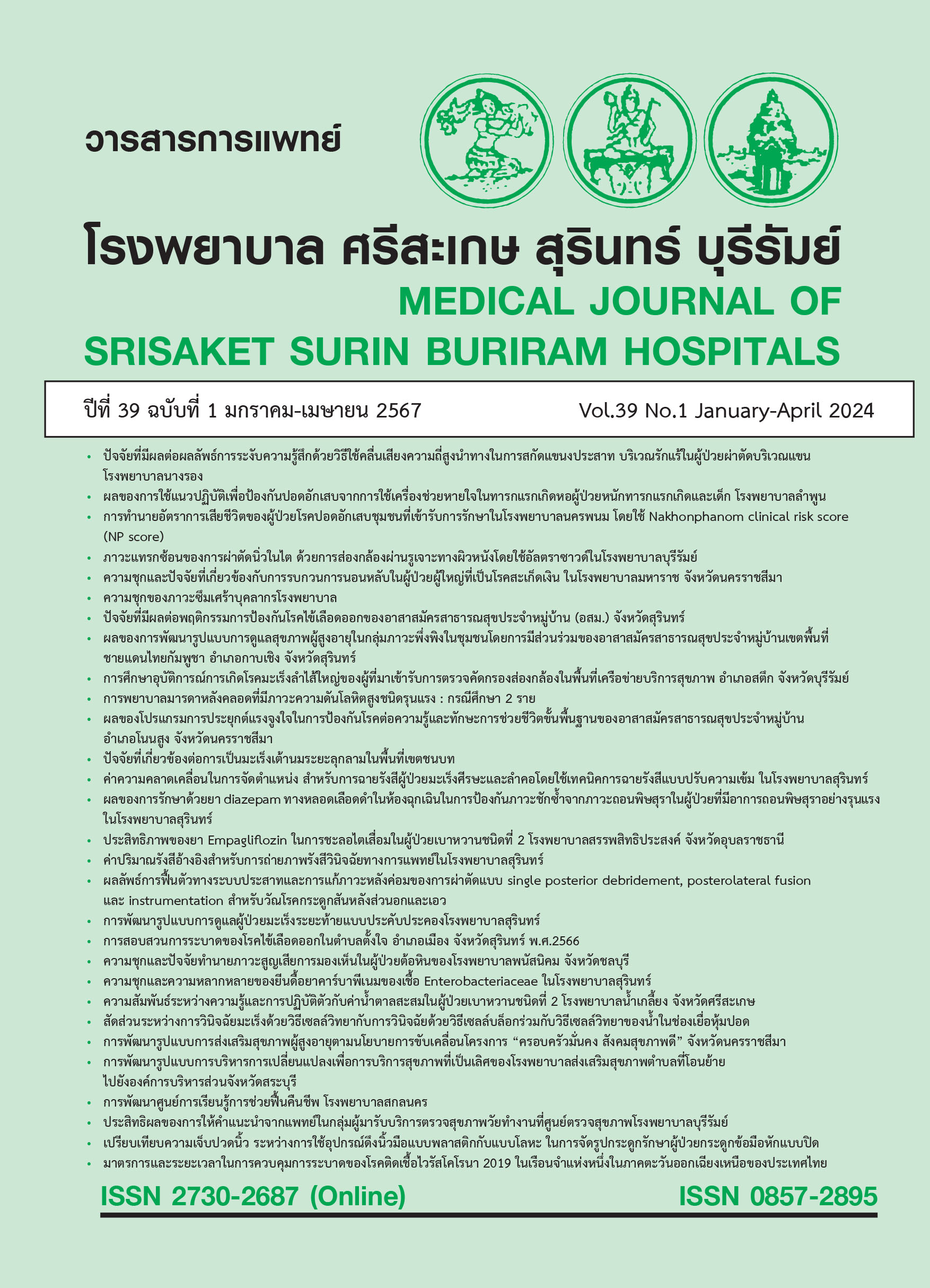ค่าความคลาดเคลื่อนในการจัดตำแหน่ง สำหรับการฉายรังสีผู้ป่วยมะเร็งศีรษะและลำคอ โดยใช้เทคนิคการฉายรังสีแบบปรับความเข้ม ในโรงพยาบาลสุรินทร์
Main Article Content
บทคัดย่อ
หลักการและเหตุผล: ค่าความคลาดเคลื่อนในการจัดท่าผู้ป่วยในแต่ละครั้งส่งผลต่อความเที่ยงตรงในการฉายรังสีแบบปรับความเข้ม (IMRT) และเป็นเทคนิคมาตรฐานในการฉายรังสีในผู้ป่วยมะเร็งศีรษะและลำคอ
วัตถุประสงค์: การศึกษานี้มีจุดประสงค์เพื่อวิเคราะห์และประเมินค่าความคลาดเคลื่อนในการจัดตำแหน่งและขอบเขตการวางแผนการรักษา (PTV) ในการรักษาผู้ป่วยมะเร็ง ศีรษะและลำคอ ได้รับการฉายรังสีด้วยเทคนิค IMRT
วิธีการศึกษา: เก็บข้อมูลความคลาดเคลื่อนในการจัดท่าจากการถ่ายภาพในแนวระนาบ 2 มิติ (KV-image) และภาพปริมาตร 3 มิติ (CBCT) ของผู้ป่วยมะเร็ง ศีรษะและลำคอ ได้รับการฉายรังสีด้วยเทคนิค IMRT ด้วยเครื่อง Elekta Harmony Pro ตั้งแต่ 1 กรกฎาคม พ.ศ.2565 ถึง 30 มิถุนายน พ.ศ.2566 ประเมินหาค่าความคลาดเคลื่อนใน 3 ด้านในแนว lateral, longitudinal และ vertical จากนั้นนำข้อมูลค่าความคลาดเคลื่อนที่ได้ไปคำนวณหาค่า systematic errors, random errors และ PTV
ผลการศึกษา: ผู้ป่วยที่เข้าเกณฑ์ศึกษาทั้งสิ้น 74 ราย 2,410 ภาพถ่าย (CBCT 666 ภาพ และ KV-image 1,744 ภาพ) พบว่า ในแนว lateral, longitudinal และ vertical ค่า systematic errors เท่ากับ 0.071 cm 0.061 cm และ 0.059 cm ตามลำดับ ค่า random errors เท่ากับ 0.11 cm 0.10 cm และ 0.10 cm ตามลำดับ ค่า PTV โดยวิธีของ van Herk เท่ากับ 0.26 cm 0.22 cm และ 0.21 ตามลำดับ
สรุป: ค่า PTV มีค่าน้อยกว่า 0.5 cm ซึ่งเป็นค่าที่เหมาะสมในการฉายรังสีผู้ป่วยมะเร็งศีรษะและลำคอ รวมถึงสามารถที่จะลด PTV ลงได้ถึง 0.3 cm ในกรณีที่ต้องการลดปริมาณรังสีต่อเนื้อเยื่อปกติ
Article Details

อนุญาตภายใต้เงื่อนไข Creative Commons Attribution-NonCommercial-NoDerivatives 4.0 International License.
เอกสารอ้างอิง
Luo MS, Huang GJ, Liu HB. Oncologic outcomes of IMRT versus CRT for nasopharyngeal carcinoma: A meta-analysis. Medicine (Baltimore) 2019;98(24):e15951. doi: 10.1097/MD.0000000000015951.
Du T, Xiao J, Qiu Z, Wu K. The effectiveness of intensity-modulated radiation therapy versus 2D-RT for the treatment of nasopharyngeal carcinoma: A systematic review and meta-analysis. PLoS One 2019;14(7):e0219611. doi: 10.1371/journal.pone.0219611.
Wu VWC, Law MYY, Star-Lack J, Cheung FWK, Ling CC. Technologies of image guidance and the development of advanced linear accelerator systems for radiotherapy. Front Radiat Ther Oncol 2011;43:132-64. doi: 10.1159/000322414.
Biau J, Lapeyre M, Troussier I, Budach W, Giralt J, Grau C, et al. Selection of lymph node target volumes for definitive head and neck radiation therapy: a 2019 Update. Radiother Oncol 2019;134:1-9. doi: 10.1016/j.radonc.2019.01.018.
Murray E, Xia P, Dorfmeyer A, Joshi N, Lee D, Koyfman S. Chapter 5 head and neck planning. In: Xia P, Godley A, Shah C, Videtic G, Suh J, eds. Strategies for Radiation Treatment Planning. New York : Springer Publishing Company ; 2018 : 55-102.
เมทินี วิเศษรินทอง. การประเมินค่า CTV to PTV margin ของตําแหน่งการฉายรังสีในผู้ป่วยมะเร็งศีรษะและลําคอที่รักษาด้วยเทคนิคการฉายรังสีแบบปรับความเข้มหมุนรอบตัวผู้ป่วยโดยใช้เครื่องถ่ายภาพเอกซเรย์คอมพิวเตอร์แบบโคน. มะเร็งวิวัฒน์ วารสารสมาคมรังสีรักษาและมะเร็งวิทยาแห่งประเทศไทย 2559;22(1):39-46.
van Herk M. Errors and margins in radiotherapy. Semin Radiat Oncol 2004;14(1):52-64. doi: 10.1053/j.semradonc.2003.10.003.
Baron CA, Awan MJ, Mohamed AS, Akel I, Rosenthal DI, Gunn GB, et al. Estimation of daily interfractional larynx residual setup error after isocentric alignment for head and neck radiotherapy: quality assurance implications for target volume and organs-at-risk margination using daily CT on- rails imaging. J Appl Clin Med Phys 2014;16(1):5108. doi: 10.1120/jacmp.v16i1.5108.
Dionisi F, Palazzi MF, Bracco F, Brambilla MG, Carbonini C, Asnaghi DD, et al. Set-up errors and planning target volume margins in head and neck cancer radiotherapy: a clinical study of image guidance with on-line cone-beam computed tomography. Int J Clin Oncol 2013;18(3):418-27. doi: 10.1007/s10147-012-0395-7.
Kataria T, Abhishek A, Chadha P, Nandigam J. Set-up uncertainties: online correction with X-ray volume imaging. J Cancer Res Ther 2011;7(1):40-6. doi: 10.4103/0973-1482.80457.
Nyarambi I, Chamunyonga C, Pearce A. CBCT image guidance in head and neck irradiation: the impact of daily and weekly imaging protocols. J Radiother Pract 2015;14(4):362-9. DOI:10.1017/S1460396915000266
Saha A, Mallick I, Das P, Shrimali RK, Achari R, Chatterjee S. Evaluating the Need for Daily Image Guidance in Head and Neck Cancers Treated with Helical Tomotherapy: A Retrospective Analysis of a Large Number of Daily Imaging-based Corrections. Clin Oncol (R Coll Radiol) 2016;28(3):178-84. doi: 10.1016/j.clon.2015.11.014.
Yin WJ, Sun Y, Chi F, Fang JL, Guo R, Yu XL, et al. Evaluation of inter-fraction and intra-fraction errors during volumetric modulated arc therapy in nasopharyngeal carcinoma patients. Radiat Oncol 2013;8:78. doi: 10.1186/1748-717X-8-78.
Tan W, Wang Y, Yang M, Amos RA, Li W, Ye J, et al. Analysis of geometric variation of neck node levels during image-guided radiotherapy for nasopharyngeal carcinoma: recommended planning margins. Quant Imaging Med Surg 2018;8(7):637-47. doi: 10.21037/qims.2018.08.03.
Yu Y, Michaud AL, Sreeraman R, Liu T, Purdy JA, Chen AM. Comparison of daily versus nondaily image-guided radiotherapy protocols for patients treated with intensity-modulated radiotherapy for head and neck cancer. Head Neck 2014;36(7):992-7. doi: 10.1002/hed.23401.
Divneet M, Quoc-Anh H, Betsy W, Gia J, Denise R, Christopher W, et al. Comparison of two thermoplastic immobilization mask systems in daily volumetric image guided radiation therapy for head and neck cancers. Biomed Phys Eng Express 2018;4(5):055007. DOI:10.1088/2057-1976/aad574


